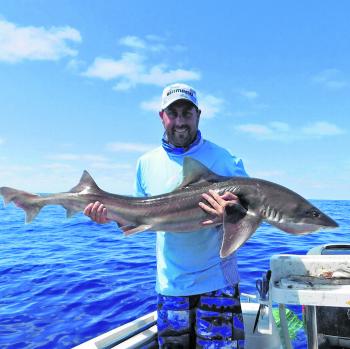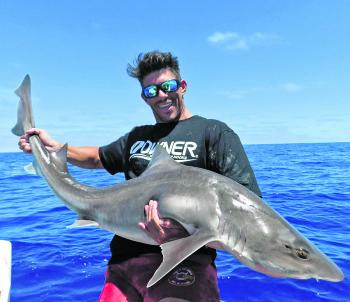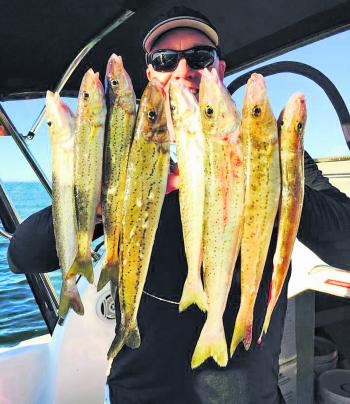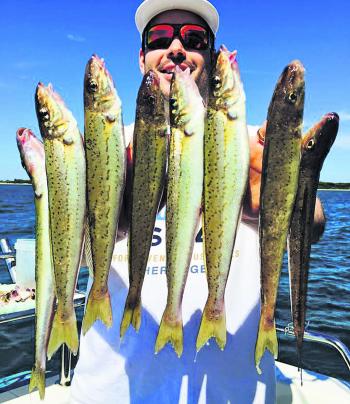The kids are all back at school and most of us are back at work but that shouldn’t keep you from heading out on the weekend in search of a tasty feed of fresh fish. This time of year is one of my all time favourites as most of the holiday-makers have headed home meaning less boat traffic on the water. There is also a plethora of species available throughout the Western Port region.
Many anglers made the switch from snapper to whiting last month, and with the snapper all but gone, the whiting have become the star of the show.
Whiting have been caught right throughout the Port but some of the more fruitful areas have been Coronet Bay, Rhyll Channel, Tortoise Head Bank, Cowes, Ventnor, Cat Bay, Flinders, Somers and Balnarring. Anglers fishing from the Beach at Balnarring into the evenings have been doing extremely well catching fish to 45cm. The fish have been more active in close on the high tides. The most successful technique has been to cast a paternoster rig tied from 15lb fluorocarbon with each dropper containing a Mustad Demon Light Circle #4. Having the sinker on the bottom of the rig allows for better casting distance while the two droppers suspend the bait above the weed.
This rig is suitable to fish from the boat over weedy terrain, but, if fishing on sand or mud use an extended single dropper paternoster or running sinker rig with a Mustad 92647S Stainless Baitholder hook. Remember though, when using a conventional J type hook, you will have to strike – on the other hand, a circle hook will allow the fish to hook itself.
Most of the larger whiting have come from locations where there has been some substantial current flow, such as Tankerton and the bottom end of the Middle Spit. In these two locations push out into 12-15m of water and set a berley trail using a wire berley cage. Fill it with thawed pilchards and mash a little, so when it hits the bottom the current carries the smaller pieces with it creating the trail. After a good ten minutes, give the cage a good shake to get the berley flowing again. When using berley, focus on casting your baits into the berley trail. Once the whiting pick up on it, this is where they’ll be. Casting left or right of the trail will result in more toadfish, trevally and salmon rather than whiting.
Shaun Furtiere from Think Big Charters has put his clients onto some fantastic whiting recently. Shaun reports that the whiting he has caught recently are quite a good class of fish with a lot between 40-50cm. While Shaun says that a wide range of baits will work, pipis, squid and mussel have been the standout baits.
When Shaun hasn’t been hitting the whiting, he has been out in search of gummy sharks with some very pleasing results. Shaun reports that he has concentrated on the Western Entrance and has caught some magnificent fish of varying weights. He says that from now on the gummy fishing will hot up right through until May.
The offshore scene has really perked up now with quite a number of anglers heading offshore in search of mako sharks, kingfish and gummy sharks. Many anglers tend to set up a berley trail for makos then bottom fish hoping to catch a mixed bag of flathead, pinkie snapper, squid and maybe a gummy.
Local angler Darren Hamilton Moore and his mate Rhodes MacKenzie headed out into Bass Strait with the intention of doing just that. Well, they certainly struck it rich managing to catch and release two thumping gummies in 65m of water.
Other anglers have had good success with both gummy shark and kingfish along the coast from Kilcunda through to The Nobbies. When the weather conditions are suitable, drift fishing in 20m of water has seen good gummies and flathead caught. Kingfish on the other hand are now in plague proportions with trolling and live bait methods the top techniques.
Lures such as the Yo-Zuri 140mm Hydro Magnum and 140mm Zerek Pelagicz have been a standout in recent weeks. If you find a reliable location to catch live yellow-tail scad and slimy mackerel then spend the much needed time and get a good 20 or so fish. When rigging them, you want maximum life expectancy in the water. Rigging through the back will have them perish quickly whereas using a bridle through the nose or an assist hook will keep them in optimum condition for the duration of time required.
It is not always easy to locate the kings, especially offshore along the coast. In this case, trolling live baits around the reefs and likely locations that they’d hold requires good rigging skills of the live bait to keep it in maximum condition. Along with that, barracouta, pike and snook are also quick to attack live baits so make sure you have enough livies to get you through a days fishing.
The Victorian kingfish season basically runs from late December through to early April with the peak time in February and March. We are now right into the peak time so there is no point making excuses as to why you can’t head out to get your fix.
There are plenty of options right around the Port at the moment from kings and ‘tings to makos and gumbos. There is no better time to be fishing on Western Port then the next few weeks so don’t pack up the boat just yet; there are still plenty of fish in the sea.
Reads: 2171
Local angler Darren Hamilton Moore with the fruits of his day fishing the Western Entrance. (Photo supplied by Darren Hamilton Moore)

There are some monster gummy sharks about at this time of year if you’re willing to work the Western Entrance. Check out Rhodes Mackenzie’s massive gummy. (Photo supplied by Darren Hamilton Moore)

Shaun Furtiere from Think Big Charters has been dominating the King George whiting throughout Western Port of late and putting his clients onto some great fish displays. (Photo supplied by Shaun Furtiere from Think Big Charters)

Client of Think Big Charters, Matt Johnston with a nice selection of Western Port whiting. (Photo supplied by Shaun Furtiere from Think Big Charters )




